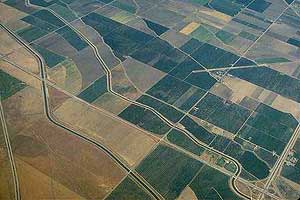| Agricultural Aviation and Wetlands Protection | |||||||||
|
Additionally, international demand is growing and new career opportunities are appearing in forestry, fish and wildlife management, aerial fire fighting, and anywhere low altitude precision flying is required. |
|||||||||
|
Modern ag pilots are highly trained professionals, with ongoing upgrading of safety, chemical, technical and environmental concerns. |
|||||||||
|
Aerial application offers some unique advantages to modern West Side farmers. The ability to apply crop protection products in a timely manner (morning and evening desiccation), or application of fungicides, herbicides, or insecticides quickly; even in wet conditions. Crop loss due to compaction is nonexistent, as are ruts or trampled straw, which can cause problems when harvesting or direct seeding. |
|||||||||
|
With these tools of technology and water quality testing, the impact of urban development on West Side agronomy, wetlands, water resources, and wildlife is monitored continually. Education is at the forefront of Clovis Agricultural Wetlands Conservancy mission. By creating higher public awareness of key issues that affect the greater Clovis wetlands environment and wildlife, we hope to play a proactive role in advancing knowledge and informing public policy through information technology and New Media publishing. |
©2000 HTML Graphics
by Clovis Free Press.
All rights reserved.
 Today's
agricultural aviator must possess the dual skills of a disciplined pilot and a
highly trained agriculturist. To meet the strict demands of modern agricultural
aviation hires and trains the best... estimated that at least 250 new pilots are
needed annually in California.
Today's
agricultural aviator must possess the dual skills of a disciplined pilot and a
highly trained agriculturist. To meet the strict demands of modern agricultural
aviation hires and trains the best... estimated that at least 250 new pilots are
needed annually in California.  In
the modern world of agriculture, the only constant is change. This axiom also
holds true for aerial application. Modern spray planes are single purpose, with
advanced spray systems, incorporating all of the technical advances (e.g., GPS
swath guidance) that are typical in all aspects of modern agriculture.
In
the modern world of agriculture, the only constant is change. This axiom also
holds true for aerial application. Modern spray planes are single purpose, with
advanced spray systems, incorporating all of the technical advances (e.g., GPS
swath guidance) that are typical in all aspects of modern agriculture. Agricultural
aviation is implementing an aerial applicator program which will ensure quality
applicators to test and modify spray equipment and patterns, and assist in educating
applicators in regard to drift management.
Agricultural
aviation is implementing an aerial applicator program which will ensure quality
applicators to test and modify spray equipment and patterns, and assist in educating
applicators in regard to drift management.  Global
Positioning Services (GPS) and infrared satellite maps are used by skilled aviators
to properly navigate and monitor physical areas of concern.
Global
Positioning Services (GPS) and infrared satellite maps are used by skilled aviators
to properly navigate and monitor physical areas of concern.